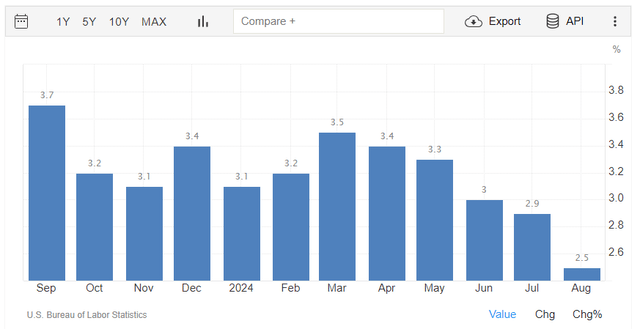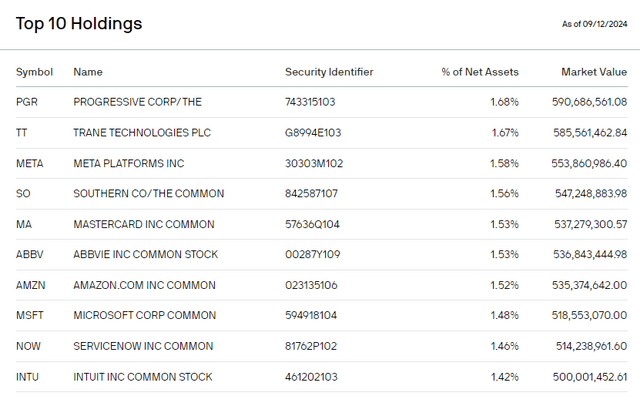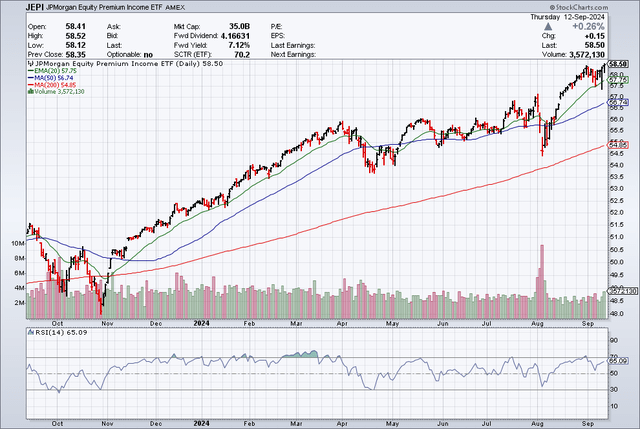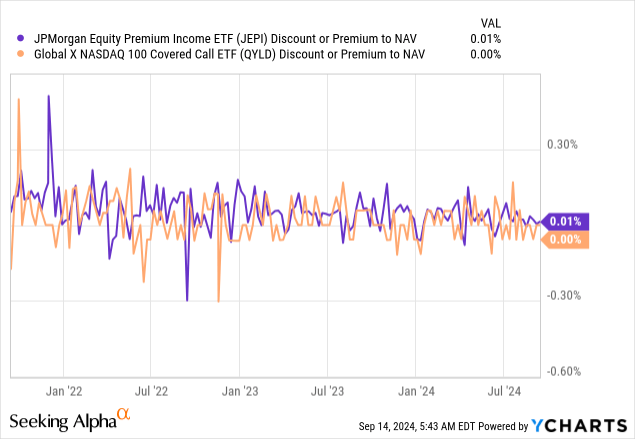
Torsten Asmus
JPMorgan Equity Premium Income ETF (NYSEARCA:JEPI) has delivered strong total returns in 2024 and the backdrop continues to be favorable: The U.S. economy is still in good shape and the central bank is poised to provide a growth stimulus by slashing interest rates.
The exchange-traded fund is a top holding in my passive income portfolio and combines equity exposure with an option writing strategy that produces recurring income.
The JPMorgan Equity Premium Income ETF presently pays passive income investors a 7% yield on their invested capital, and the ETF’s NAV has room to grow in 2024.
My Rating History
I presented the JPMorgan Equity Premium Income ETF as an attractive investment vehicle in November for passive income investors to hedge against a prolonged high-rate environment. But even in a low-rate environment, I think that the JPMorgan Equity Premium Income ETF has substantial NAV growth potential.
Since the ETF is also using options to enhance its income, JEPI is a very solid equity-focused ETF that should appeal to those investors that need or want to generate passive income in 2024.
Receding Inflation And Pro-Cyclical Portfolio Positioning
Inflation amounted to 2.5% in August, reflecting a 0.4% decline compared to the prior month. Inflation has trended down for a while now and reached, in August 2024, its lowest point since February 2021.
Slowing inflation is making interest cuts much more probable at this month’s Fed meeting, with lower short-term interest rates being generally regarded as a positive for the economy.

Inflation (U.S. Bureau Of Labor Statistics)
The JPMorgan Equity Premium Income ETF is a diversified, equity-focused exchange-traded fund that, besides owning a portfolio consisting of major American companies, writes out-of-the-money S&P 500 Index call options in order to distribute portfolio income that gets paid to investors on a monthly basis.
The ETF’s top investments include Progressive Corp. (PGR), Meta Platforms Inc. (META), Amazon (AMZN), Mastercard (MA) and Microsoft (MSFT), to name just a few here. The focus on fast growing technology companies with connection to the AI theme is something that, I think, should be regarded as particularly compelling for passive income investors.
Technology companies have been instrumental in driving stock indices to record highs this year, and companies like Nvidia Corp. (NVDA) have seen their valuations skyrocket as of late as companies shifted ever-increasing amounts of money into artificial intelligence developments. A portfolio breakdown for JEPI as of 09/12/2024 is provided below.

Top 10 Holdings (JPMorgan Equity Premium Income ETF)
Technical Analysis
In late 2023, the JPMorgan Equity Premium Income ETF broke out to the upside as investors started to anticipate that the central bank would cut its short-term interest rates. The JPMorgan Equity Premium Income ETF has produced an 11.4% NAV return so far this year as stock markets performed well, partially because of strong demand for artificial intelligence products in the Information Technology sector.
From a technical angle, the JEPI is very much in a promising setup, as the ETF recovered the 50-day moving average in August and has since moved into striking distance of new 52-week highs as well. The JPMorgan Equity Premium Income ETF is presently selling above the 20-day, 50-day and 200-day moving averages, which creates a bullish backdrop for investors.
With stocks rebounding broadly from the August selloff, I think that JEPI could continue to be a promising momentum investment for passive income investors.
On the flip side, if the 50-day moving average line were to break, then the ETF would have immediate downside to $54.85 which is where the 200-day moving average line runs at the present moment.

Relative Strength Index (Stockcharts.com)
JEPI Versus QYLD
The JPMorgan Equity Premium Income ETF has a four-star performance rating from Morningstar, making it a strong performance candidate for passive income investors, and has produced more than 13% annualized NAV returns since inception in 2020.

NAV Return (JPMorgan Equity Premium Income ETF)
An alternative to JEPI is the Global X NASDAQ 100 Covered Call ETF (QYLD) which also sells calls to supplement its income. The QYLD, however, is much less popular than JEPI and has a poorer investment record: The Global X NASDAQ 100 Covered Call ETF produced a three-year annualized NAV return of only 4.4% compared to 7.2% for JEPI.
The JPMorgan Equity Premium Income ETF is also much bigger, with assets under management of $35 billion (compared to just $8.0 billion for QYLD). JEPI’s bigger size and stronger NAV returns also allow the ETF to charge much less (0.35%) than the Global X NASDAQ 100 Covered Call ETF, which charges its investors 0.61% of assets.
Tiny Discount To NAV For JEPI
Exchange-traded funds like the JPMorgan Equity Premium Income ETF are to be valued on a NAV since the underlying components, the ETF’s equity holdings, are marked-to-market. The JPMorgan Equity Premium Income ETF’s net asset value as of 09/12/2024 was $58.53 which means the ETF is presently valued at a discount to NAV of 0.04% at the time of writing.
Taking into account that the U.S. economy is growing and inflation is receding, I think that the JPMorgan Equity Premium Income ETF has a good chance to see robust growth in its underlying NAV in 2024.
Further employment gains and rate cuts could provide fuel to the U.S. economy, which then further tilts the odds for upside in JEPI’s underlying NAV.
A core focus on technology companies with AI exposure is also a factor why the JPMorgan Equity Premium Income could be a good investment for long-term passive income investors.

Why The Investment Thesis Has More Risk
Equity markets are doing quite well right now, and the S&P 500 reached a large number of consecutive all-time highs so far in 2024. The central bank announcement in December 2023 that a Fed shift was soon in the cards also boosted investor sentiment and made stock investments compelling. The central bank is poised to lower short-term interest rates soon, which could give the stock market another shot into the arm.
Since the JPMorgan Equity Premium Income ETF is an equity-dominated exchange-traded fund, JEPI likely won’t do well in a recession or if the U.S. economy were to see a major inflation flare-up.
My Conclusion
The JPMorgan Equity Premium Income ETF is a highly attractive passive income vehicle for investors that seek durable dividend income from a diversified, equity-focused exchange-traded fund. The option selling strategy further enhances the ETF’s income appeal, and passive investors can presently lock in a 7% yield.
With the U.S. economy growing and inflation finally subsiding, I think that JEPI could enjoy NAV growth in 2024, particularly if the AI boom continues to elevate the stock index to new highs. The U.S. election may be another positive catalyst for the stock market.
The JPMorgan Equity Premium Income ETF presently provides passive income investors with a solid yield as well as monthly dividend income. Taking into account that the macro is looking quite good right now, I think JEPI could potentially march on to see new highs and build on its positive momentum. Buy.

Comments